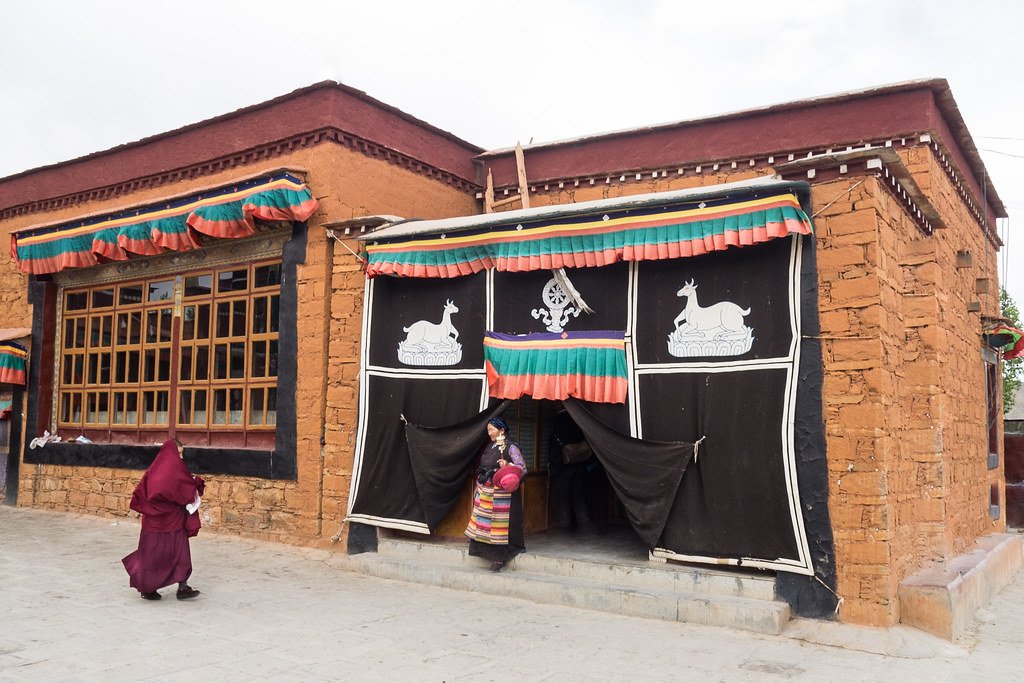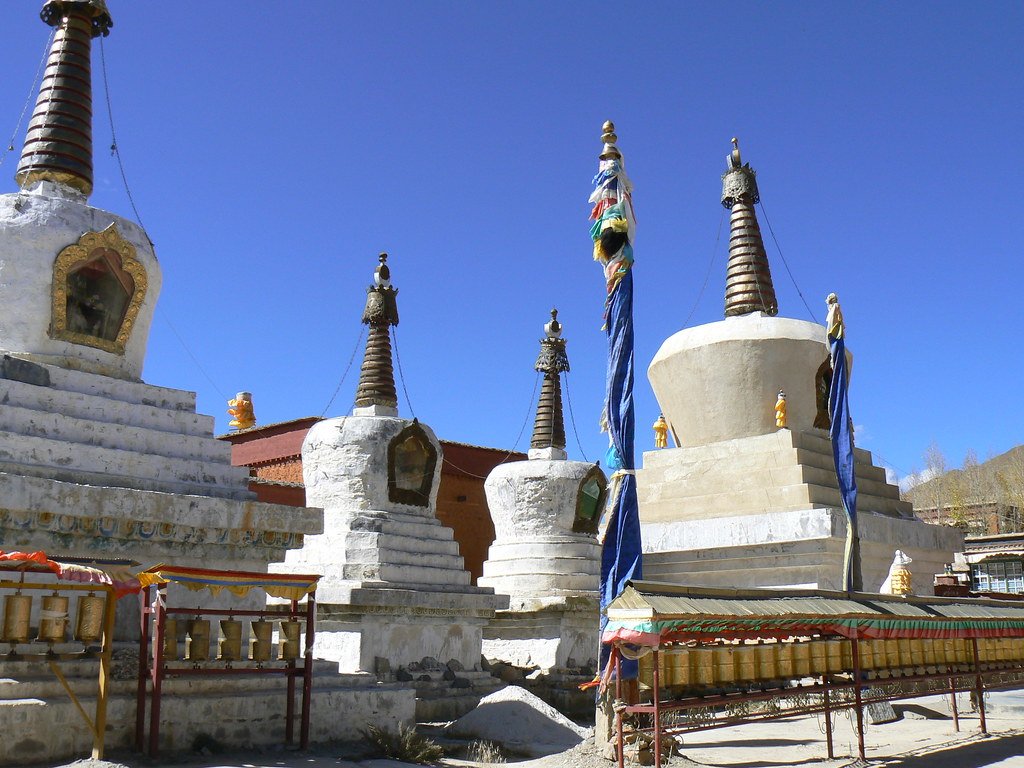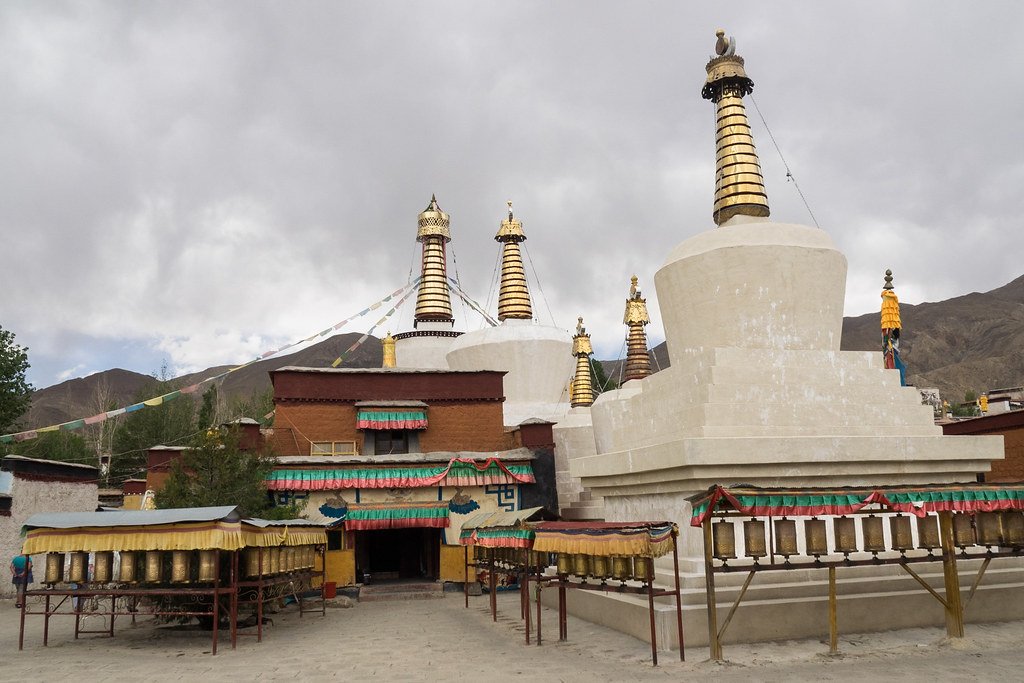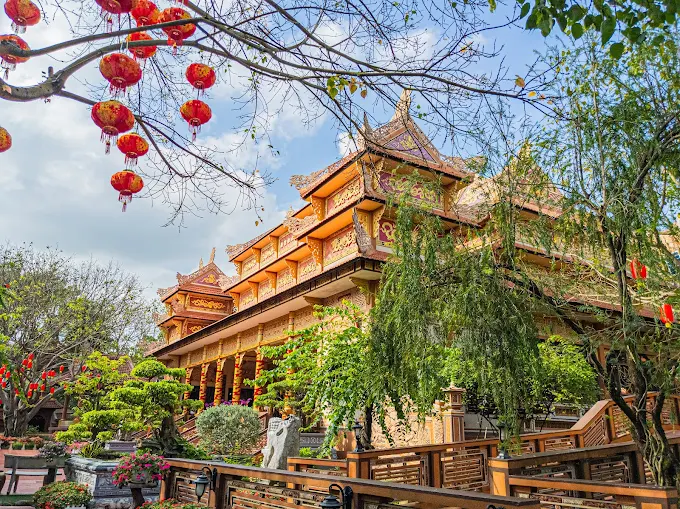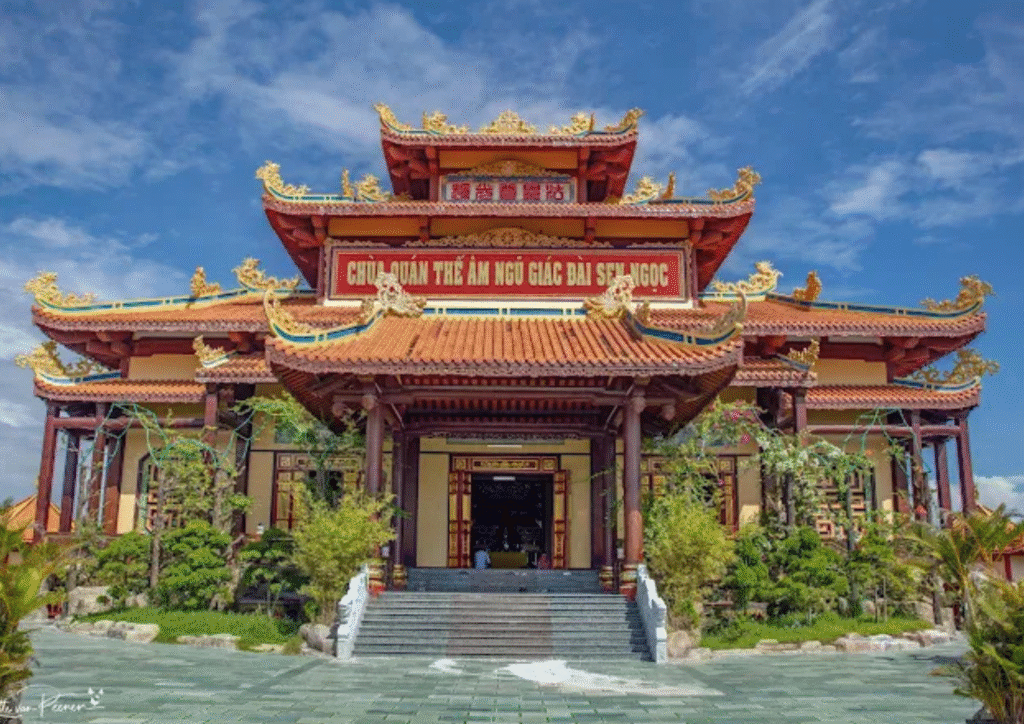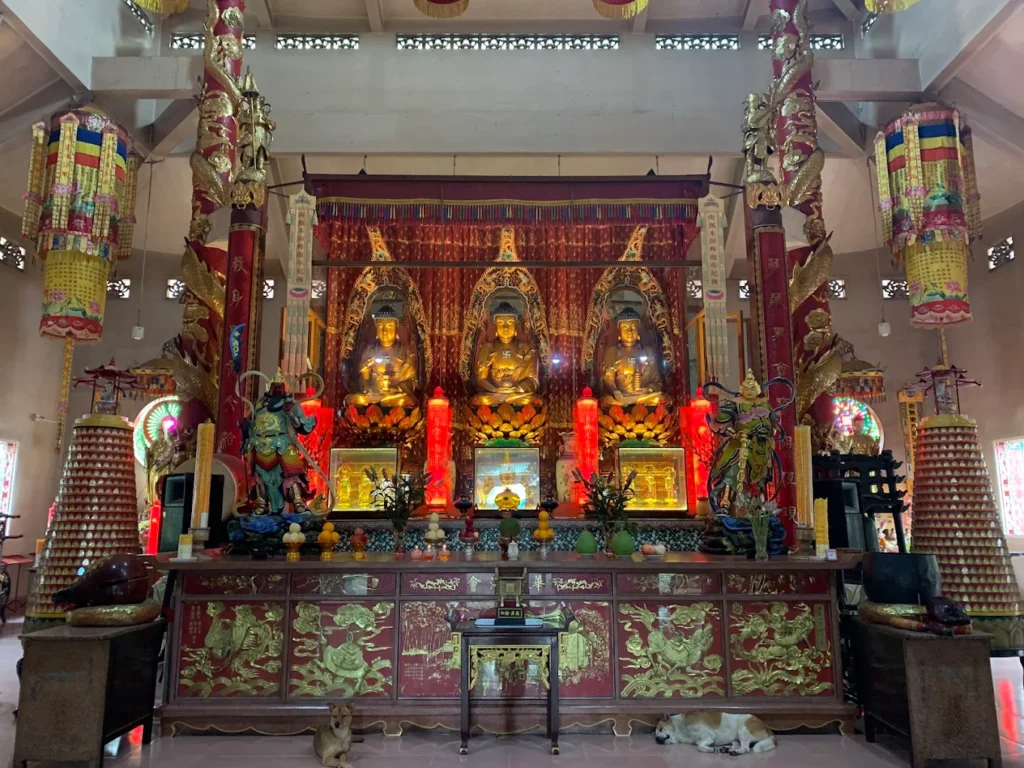Rabse Nunnery: The Prayer Flag Haven of Gyantse’s Hills
Rabse Nunnery, tucked behind a gentle hill between Palcho Monastery and Gyantse Dzong in Tibet, glows as a serene sanctuary of the Red Hat sect, its prayer flags fluttering like whispers of devotion. Established in its current location in 1985 after the destruction of two older sites, this ani gompa (Tibetan nunnery) houses 44 nuns who nurture a vibrant spiritual life amidst chortens and mani lhakhang (prayer wheel chapels). Its intimate setting, adorned with colorful thangka paintings and butter lamps, offers a peaceful retreat for pilgrims and travelers seeking authentic Tibetan Buddhist culture. This immersive listing unveils Rabse’s essence, guiding you through its quiet history, architectural charm, sacred rituals, and practical visitor insights, offering a journey into a hidden gem of Gyantse’s spiritual landscape.
The Serene Soul of Rabse
Essence of Rabse Nunnery
Rabse Nunnery radiates a tranquil spirituality, embodying the Red Hat sect’s devotion to compassion and meditation. Relocated in 1985 to its current site behind Gyantse’s iconic hill, it serves as a haven for 44 nuns who maintain its prayer-filled ambiance. Its defining feature—a maze of prayer flag-draped paths lined with chortens and mani stones—creates a meditative oasis, drawing visitors into its gentle embrace. Hidden from Gyantse’s bustle, Rabse offers a glimpse into the quiet strength of Tibetan Buddhist nuns.
- Spiritual Core: Red Hat sect ani gompa, home to 44 nuns.
- Iconic Feature: Prayer flags, chortens, and mani lhakhang paths.
- Cultural Role: A center for female Buddhist practice and devotion.
Historical Evolution
Rabse’s history is rooted in two older nunneries higher in Gyantse’s hills, both destroyed during the Cultural Revolution (1966–1976). In 1985, the nuns rebuilt at the current site, a move guided by local devotion and practical necessity. Though less documented than larger monasteries, Rabse’s Red Hat lineage ties it to Padmasambhava’s 8th-century teachings, shared with nearby Guru Lhakhang Temple. Restoration efforts, supported by local villagers, have preserved its Gomang chorten and thangka paintings, maintaining its spiritual legacy despite a modest scale.
- Origins: Evolved from two older hilltop nunneries.
- Relocation: Rebuilt in 1985 post-Cultural Revolution.
- Preservation: Restored with local support, tied to Red Hat roots.
Cultural Impact
Rabse Nunnery fosters the Red Hat sect’s traditions, preserving rituals and thangka art that reflect Padmasambhava’s influence. Its role as an ani gompa highlights the vital contributions of Tibetan nuns, often overshadowed by male monastic sites. Locally, it serves as a pilgrimage stop on Palcho’s kora, while globally, its charm draws cultural enthusiasts via travel narratives on Lonely Planet and Wonders of Tibet. Rabse’s prayer flags and mani stones symbolize Tibet’s enduring Buddhist heritage.
- Red Hat Legacy: Preserves Padmasambhava-inspired rituals.
- Nuns’ Role: Showcases female Buddhist contributions.
- Global Appeal: Featured in travel guides, draws cultural explorers.
Signature Legacy
Rabse’s prayer flag-draped paths, weaving through chortens and mani lhakhang, are its crowning jewel, creating a visual and spiritual symphony. The Gomang chorten, reconstructed post-1985, holds inner murals that, though often locked, hint at ancient artistry. A local tale speaks of a nun’s vision guiding the 1985 relocation, where a prayer wheel spun spontaneously, marking the site as sacred. These elements anchor Rabse’s identity as a place of quiet devotion.
- Prayer Flags: Colorful paths, a spiritual hallmark.
- Gomang Chorten: Rebuilt with hidden murals.
- Relocation Legend: Vision of a spinning prayer wheel.
Community and Global Reach
Gyantse locals cherish Rabse, offering butter lamps and prayers during festivals and life events. The 44 nuns, living simply, maintain the nunnery’s rituals and welcome pilgrims with warmth. The Tibetan diaspora connects with Rabse’s Red Hat heritage, while international visitors, inspired by sources like Lonely Planet, seek its authenticity. Its inclusion in Gyantse’s kora path extends its spiritual influence, uniting locals and travelers in shared devotion.
- Local Devotion: Prayers and offerings by Gyantse residents.
- Nuns’ Community: 44 nuns uphold rituals, welcome visitors.
- Global Reach: Draws diaspora and cultural tourists.
Architectural Charm of Rabse
Distinctive Design
Rabse’s architecture is intimate and functional, nestled behind a hill at 3,900 meters, blending seamlessly with Gyantse’s rugged landscape. Its modest complex, centered on the main assembly hall, features whitewashed walls draped in prayer flags and dotted with chortens. The Red Hat sect’s influence is evident in vibrant mani lhakhang and prayer wheel paths, creating a pilgrim-friendly layout. This simplicity contrasts with grander monasteries, offering a homely charm unique to ani gompas.
- Style: Red Hat sect simplicity, prayer flag-draped.
- Layout: Assembly hall with chortens and mani lhakhang.
- Setting: Hidden behind hill, blending with landscape.
Signature Structures
The main assembly hall, a low-roofed structure, houses thangka paintings of Padmasambhava and Chenresig, glowing under butter lamp light. The Gomang chorten, rebuilt post-1985, stands in the courtyard, its inner murals rarely accessible but evocative of Red Hat artistry. Mani lhakhang chapels, with large prayer wheels, line the kora path, inviting pilgrims to spin them clockwise. A small shrine near the entrance holds a self-arising mani stone, believed to bless visitors.
- Assembly Hall: Thangkas of Padmasambhava, Chenresig.
- Gomang Chorten: Rebuilt with hidden murals.
- Mani Lhakhang: Prayer wheel chapels along kora.
Artisanal Mastery
Rabse’s thangka paintings, crafted by local nuns, depict Red Hat deities with mineral pigments, their vibrant hues enduring despite modest resources. The Gomang chorten’s murals, painted post-reconstruction, use traditional techniques, blending Nepalese and Tibetan styles. Prayer wheels, carved with mantras, reflect local woodworking, while chortens are adorned with clay reliefs of lotus motifs. These artisanal works, though small-scale, showcase the nuns’ dedication to preserving Red Hat aesthetics.
- Thangkas: Nun-crafted, vibrant Red Hat deities.
- Murals: Traditional pigments in Gomang chorten.
- Prayer Wheels: Mantra-carved, local craftsmanship.
Hidden Architectural Gems
Rabse hides subtle treasures within its compact grounds. The kora path’s prayer flag canopy, fluttering in the breeze, creates a tunnel of color, offering serene views of Gyantse Dzong. A faded mani stone wall, etched with Om Mani Padme Hum, lines the courtyard’s edge, inviting quiet reflection. The assembly hall’s upper balcony, rarely accessed, provides a vantage point over Palcho Monastery, connecting Rabse to Gyantse’s sacred landscape.
- Prayer Flag Canopy: Colorful kora tunnel.
- Mani Stone Wall: Faded mantra carvings.
- Upper Balcony: Views of Palcho and Dzong.
Preservation and Evolution
Preserving Rabse’s modest structures is a labor of love for its nuns, who repair prayer wheels and thangkas with traditional materials despite limited funds. Post-1985 restoration, supported by local villagers, rebuilt the Gomang chorten and assembly hall, using mud-brick techniques. Harsh Tibetan winters threaten murals, but the nuns’ ongoing care ensures their survival. Future preservation relies on community donations, maintaining Rabse’s delicate charm.
- Restoration: Gomang chorten, hall rebuilt in 1985.
- Maintenance: Nun-led repairs with mud-brick, pigments.
- Challenges: Winter climate, limited funding.
Sacred Rites and Quiet Devotion
Sacred Daily Rites
Each dawn, Rabse stirs with soft chants, as nuns gather in the assembly hall to recite sutras, their voices mingling with butter lamp smoke. Pilgrims spin prayer wheels along the kora, offering khatas (silk scarves) at the Chenresig thangka, their prayers filling the air. The rustle of prayer flags and hum of mantras create a meditative ambiance, enveloping visitors in Rabse’s gentle spirituality.
- Chanting: Morning sutras in assembly hall.
- Offerings: Khatas at Chenresig thangka.
- Ambiance: Prayer flags, mantra hum.
Unique Spiritual Practices
Rabse’s nuns perform Red Hat rituals, including Padmasambhava-focused recitations, reflecting the sect’s tantric roots. The kora, a clockwise pilgrim trail lined with prayer wheels, is central, believed to purify karma as pilgrims spin each wheel. Butter lamp offerings, lit daily, honor Chenresig, with nuns teaching visitors the practice. These rituals, intimate and accessible, distinguish Rabse’s spiritual identity.
- Padmasambhava Recitations: Red Hat tantric rites.
- Kora: Prayer wheel-lined pilgrim trail.
- Butter Lamps: Chenresig offerings, visitor-friendly.
Vibrant Festival Traditions
Rabse’s festivals, though modest, echo Gyantse’s vibrancy. During Saka Dawa, marking Buddha’s enlightenment, nuns lead kora walks and lamp offerings, joined by locals. The Gyantse horse-racing festival, held nearby, sees Rabse host prayers, with nuns blessing participants. Sharing tsampa (roasted barley) and butter tea fosters community spirit, linking Rabse to Gyantse’s cultural pulse.
- Saka Dawa: Kora and lamp offerings.
- Horse-Racing Festival: Prayers for participants.
- Community Role: Tsampa and tea shared.
Visitor Engagement
Visitors can offer khatas or light butter lamps, guided by nuns, immersing in Rabse’s spiritual life. Photography is permitted, capturing prayer flags and chortens, but flash is discouraged in the assembly hall. Joining the kora lets travelers walk with pilgrims, feeling Rabse’s sacred rhythm. Nuns may share stories of the nunnery’s relocation, adding depth to the visit.
- Offerings: Khatas, lamps with nun guidance.
- Photography: Allowed, no flash in hall.
- Kora Participation: Walk with pilgrims.
Monastic and Community Roles
Rabse’s 44 nuns maintain daily rites, study Red Hat texts, and guide visitors, embodying resilience and devotion. They offer blessings for local harvests or life events, strengthening Gyantse ties. The nunnery trains young nuns in thangka painting, preserving Red Hat artistry. This bond ensures Rabse remains a living spiritual haven, despite its small scale.
- Nun Duties: Rites, study, visitor guidance.
- Community Ties: Blessings for local events.
- Art Preservation: Thangka training.
Visiting Rabse Nunnery
Navigating to Rabse Nunnery
Rabse Nunnery lies behind the hill between Palcho Monastery and Gyantse Dzong in central Gyantse, 100 km southeast of Shigatse. From Lhasa, a 260-km drive via the G318 highway takes 5 hours by bus or private tour vehicle, passing Shigatse. In Gyantse, follow the kora path from Palcho Monastery, a 10-minute walk clockwise around the hill, marked by prayer flags. The nunnery’s chortens are visible from the path.
- From Lhasa: 5-hour drive via Shigatse on G318.
- From Shigatse: 2-hour drive, 100 km northwest.
- Local Access: 10-minute kora walk from Palcho.
Address of Rabse Nunnery
- Location: Gyantse Town, Gyantse County, Shigatse, Tibet Autonomous Region, China.
- Coordinates: 28.9333° N, 89.6667° E (approximate, near Palcho).
- Context: Behind hill, between Palcho and Dzong.
Visiting Hours and Etiquette
Rabse is open daily from 9:00 AM to 5:00 PM, with early visits offering quieter exploration. Dress modestly, covering shoulders and knees, and remove hats in the assembly hall. Photography is allowed but avoid flash near thangkas; ask nuns for permission in sacred areas. Respect pilgrims by maintaining silence and not touching relics or prayer wheels.
- Hours: 9:00 AM–5:00 PM, best in morning.
- Dress Code: Modest clothing, no hats in hall.
- Etiquette: No flash, silence near relics.
Accessibility and Safety
Rabse’s grounds are accessible via flat kora paths, but some chapels involve steps, challenging for those with mobility issues. Wheelchair users need assistance due to uneven terrain; arrange with tour operators. Gyantse’s 3,900-meter altitude requires acclimatization; hydrate and rest to avoid sickness. The setting is safe, but watch for festival crowds and stray dogs.
- Accessibility: Flat paths, some steps in chapels.
- Mobility Aids: Limited, arrange assistance.
- Safety: Acclimatize, watch for crowds.
Amenities and Surroundings
Rabse offers no restrooms or shops; bring water and snacks. Gyantse’s nearby markets, a 10-minute walk, serve momos (dumplings) and butter tea, immersing visitors in local flavors. The kora path’s prayer flags and chortens provide serene reflection spots. Gyantse’s old town, with shops and teahouses, buzzes with charm, offering views of the Dzong.
- Amenities: None on-site, bring essentials.
- Food: Gyantse markets with momos, tea.
- Surroundings: Prayer flags, old town vibrancy.
Immersive Visitor Tips
Arrive at dawn to hear nuns chanting, their voices drifting through the assembly hall, creating a meditative start. Photograph the prayer flag canopy from the kora’s midpoint, capturing chortens against the Dzong’s silhouette, avoiding flash for thangkas. Walk the kora at dusk, when prayer flags glow golden, enhancing Rabse’s tranquility. Savor butter tea in Gyantse’s markets, chatting with locals for cultural insights.
